This journal is brought to you by...
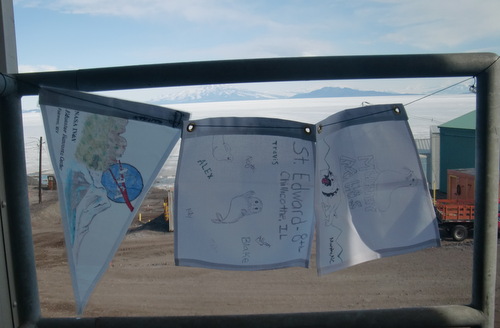
- NASA IV & V , Education Resource Center
- Becky Shimp and her 8th graders at St. Edward School
- Susan Steiner and her 9th grade class at Murphy High school
Can you muscle up the strength to learn about muscles?
My aching muscles have me thinking about all the things I do in Antarctica that require muscles! Every day, we walk around with heavy boots, wear about 10 pounds of heavy clothing, load equipment on the truck, put equipment on the snow machines, carry equipment to the seals, unload the equipment, work with a seal, work with another seal, load the equipment back on the snow machines and go back to the lab to process the day’s samples.
Whew! My muscles hurt just thinking about all that work! It also got me thinking about how muscles work. What do you know about muscles? I bet you would like to know more about muscles too.
Muscle Movement
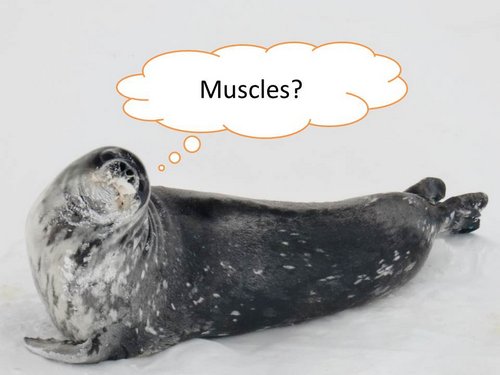
What did you come up with?
Alright, you can do a little experiment with me and make some observations. Flex your fingers. Do you think muscles moved when you moved you fingers? Of course they did! This is called voluntary muscle movement. Voluntary muscle movement occurs when you purposefully think about using a muscle and then you use it. We use our muscles intentionally when we work with the seals!
Now sit very still. Do you think you moved any muscles while you were sitting still? You actually use lots of muscles even when you are sitting still. Your heart was beating and you were breathing, I bet. Things like blinking, breathing and your heartbeat are all examples of involuntary muscle movement. Involuntary muscle movement happens all on its own. You don’t have to think about how to keep your heart beating. You usually don’t notice the tiny muscles in your eyelids that blink every few seconds. You may not even know that there are muscles in the lining of your stomach and intestines to help digest the food you eat.
See if you can think of other examples of voluntary and involuntary muscle movement.
Muscle Makeup
It’s the time of year when the seals spend a good portion of time on the ice, so we haven’t seen them move a whole lot. They’ve been resting and soaking up the sun. But I know, and I’m sure you’ve figured out, that Weddell seals use their muscles all the time. And, just like us, they have involuntary muscles that work behind the scenes to maintain normal body functions. They also have incredible muscles that are specially adapted to what they do best – swim and dive.
What fuels all that muscle movement in the seals body? In order to keep their muscles working when a seal is swimming, it needs energy. Take a deep breath. You just inhaled one of the things that helps provide muscles with energy, oxygen! How do seals get oxygen to their muscles when they spend so much of their time underwater?
Hemoglobin - the protein in blood that carries oxygen to organs and tissue.
Seals have lots of hemoglobin. They actually have more hemoglobin than we do! This extra hemoglobin is one of the reasons they can hold their breath longer than you or me. Hemoglobin isn’t the only important protein in the seals body. Seals have myoglobin in their muscles.
Myoglobin - oxygen-carrying protein that helps store oxygen in the muscle.
Myoglobin grabs the oxygen from the hemoglobin in the blood and stores it in the muscles.
All animals have hemoglobin and myoglobin in their bodies. You can actually tell how much myoglobin is in a muscle just by looking. Myoglobin has pigment or color to it. The more myoglobin present in the muscle, the redder or darker the muscle appears.
Can you tell me which of these animals has the most myoglobin? Which has the least?
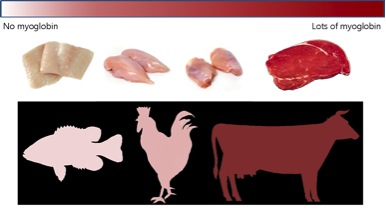
The more a muscle is used, the more myoglobin it has. Why do you think that is? The more a muscle is used, the more oxygen it needs to store in the muscle.
- Fish like flounder have extremely low levels of myoglobin in their muscle, making the fish filet appear white.
- Chicken has both white meat (breast and wing) and dark meat (leg and thigh). Why do you think that is? Chickens stand and roam, using their thigh and leg muscles. Since those muscles are used more, they require more oxygen, therefore, their myoglobin levels are higher and the meat appears darker. Chickens rarely use their breast and wing, since they don’t fly much. So, these muscles have less myoglobin and appear lighter in color or ‘white’.
- Cattle are very large and stand most of the time, so their muscles need to work hard. Look at the muscle of the cow above. The juicy steak has high levels of myoglobin. How can you tell? Just look at how red the steak is!
- But what about the Weddell seal? Do you think the seal has high or low levels of myoglobin? Will the seal’s muscles appear darker than the steak?
If you said darker, you are correct. The Weddell seal’s muscle has so much myoglobin that its muscle looks almost black. It has about 10 times more than a cow!
Their muscle color is off the chart!
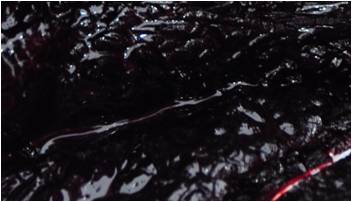
Check out this interactive muscle chart.
Its purpose is to store oxygen, which is needed to produce energy, which the muscles need when they are working. The more myoglobin an animal has in its muscle cells, the longer that animal can do work, like swimming or holding its breath under water. Weddell seals, whales and other swimming and deep-diving marine mammals have very high levels of myoglobin. So, the oxygen stored in the muscles is very useful for seals when they go on deep dives foraging, or looking for food.
Oxygen efficiency
These seals are exceptionally efficient about oxygen. Their bodies have:
- Organs and tissue that must have oxygen to produce energy, like the brain and nervous system.
- Organs and tissue that prefer to have oxygen to produce energy, like muscles.
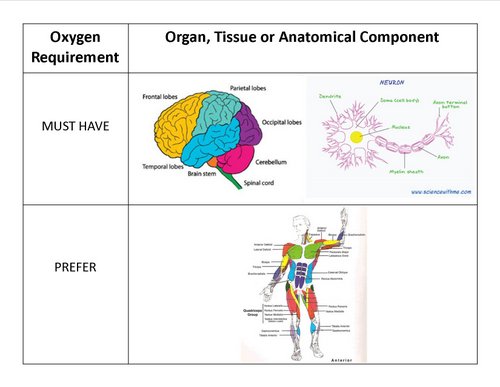
If the first group does not get the needed oxygen, the entire body will shut down, but if the second group does not get oxygen, there is a backup plan.
Myoglobin in the muscles really likes oxygen – much more than hemoglobin likes oxygen. So, if the seal is working hard and using oxygen – swimming, diving and hunting for food – the seal’s muscles would take all the oxygen. Do you see a problem here? If the seal is working really hard and the blood is flowing to the muscles, the myoglobin in the muscles would keep all the oxygen. That’s not a good thing for an organ like the brain. But don’t worry! It’s not a problem for an animal as efficient as a Weddell seal!
When these seals go on really, really long dives, they have the ability to adjust their blood flow, keeping blood flowing to the more vital organs and tissues, such as the brain. It’s like the seal is saying, ‘Hey muscles, handle this on your own. Generate your own power using the oxygen you have stored in your muscles. We’re not going to give you any more. Blood’s not going to flow to the muscles for a while.’
This usually happens if a dive lasts longer than 20 minutes.
The solution: They typically dive for less than 20 minutes at a time, which means they only have to come up for a few breaths before they can go back underwater.
That’s quite an amazing and efficient animal!
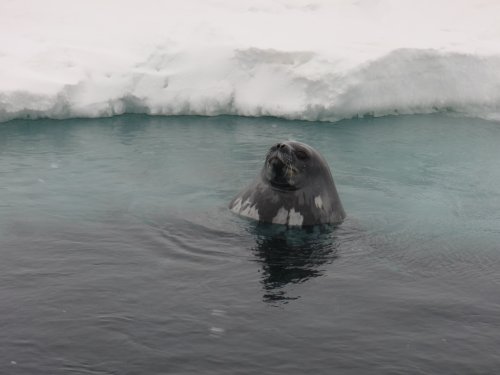
Weddell seals have some amazing muscles! The Weddell seal is much better at storing oxygen in its muscles than we are. However, the way that our muscles work is very similar to how a Weddell seal’s muscles work.
Hold your pointer finger up. Now bend your pointer finger. What is happening in your finger muscles to make your finger curl up like that? The muscles are contracting. Muscle contraction is how we generate movement so we can walk, talk and move objects.
How do muscles contract?
To understand how a muscle contracts, we need to understand what a muscle is made of. If you look at a muscle strand under a very powerful microscope, you will see a bunch of lines. These lines are called filaments. A muscle is made up of two kinds of filaments. There is a thick filament and a thin filament. These filaments alternate like stripes.
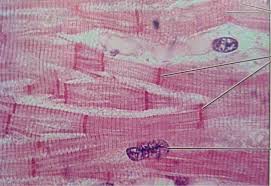
Filaments
Thick filaments are made up of a protein called myosin. Myosin is a motor protein which means it moves! Myosin looks kind of like a tad pole. It has a large area called the head and a long, thin region called the tail. The tails of myosin get all interwoven like a scarf and they form the thick filament while the heads of the myosin protein lay along the side of the shaft formed by the tails.
Thin filaments are made up of a protein called actin. Actin is shaped like a ball. All these little balls of actin line up into two rows. The rows of actin then twist around each other to form the thin filament. On each little ball of actin, there is a place where the head of the myosin molecule can attach to the actin molecule.
Can you identify the thick and thin filament?
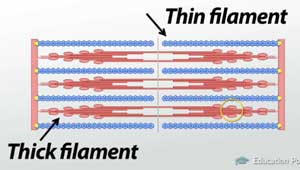
When muscles contract the two molecules of myosin and actin interact. The myosin head extends away from the shaft of the thick filament. The myosin grabs onto one of the actin molecules in the thin filament. Then, the myosin pulls the actin molecule towards it. As the myosin head pulls the actin closer, the long chain of actin follows behind. All these myosin heads keep attaching and pulling the actin chains. As the thin filaments are pulled by the thick filaments, your muscles contract!
Think about yourself and your friends as myosin proteins. Now think about a rope being a chain of actin molecules. You and all your friends could form a line. Then, you could pick up the rope. To pull the rope towards you, you and your friends would use your hands to pull the rope in the direction you wanted. Your hands are like the head of the myosin protein. Your hands attach to the rope and pull it in unison making the rope come towards you. That is exactly what myosin molecules do to the actin chain! Oh my, talking about all these muscles has given my brain a good workout!


Comments